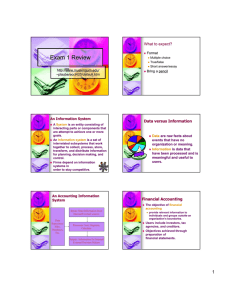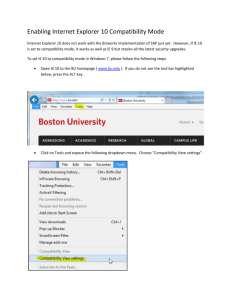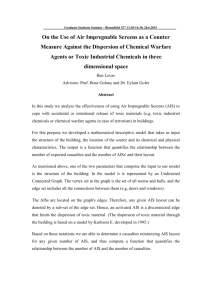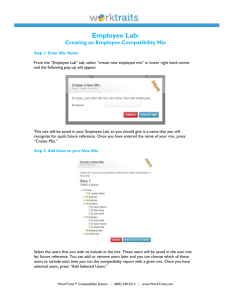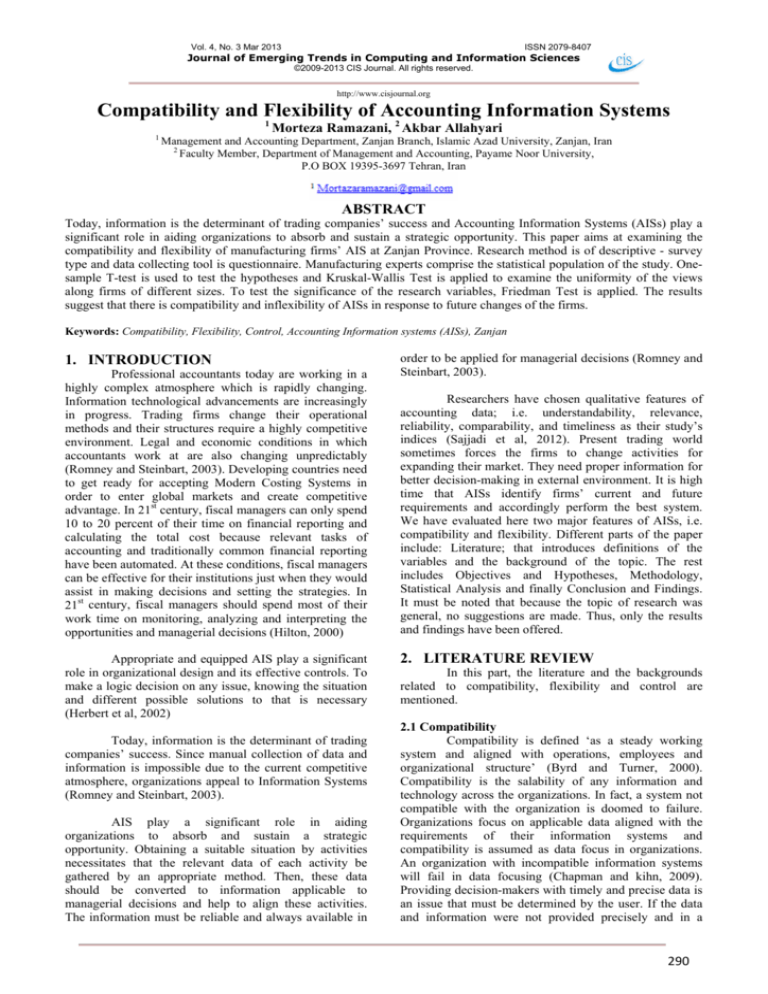
Vol. 4, No. 3 Mar 2013
ISSN 2079-8407
Journal of Emerging Trends in Computing and Information Sciences
©2009-2013 CIS Journal. All rights reserved.
http://www.cisjournal.org
Compatibility and Flexibility of Accounting Information Systems
1
1
Morteza Ramazani, 2 Akbar Allahyari
Management and Accounting Department, Zanjan Branch, Islamic Azad University, Zanjan, Iran
2
Faculty Member, Department of Management and Accounting, Payame Noor University,
P.O BOX 19395-3697 Tehran, Iran
ABSTRACT
Today, information is the determinant of trading companies’ success and Accounting Information Systems (AISs) play a
significant role in aiding organizations to absorb and sustain a strategic opportunity. This paper aims at examining the
compatibility and flexibility of manufacturing firms’ AIS at Zanjan Province. Research method is of descriptive - survey
type and data collecting tool is questionnaire. Manufacturing experts comprise the statistical population of the study. Onesample T-test is used to test the hypotheses and Kruskal-Wallis Test is applied to examine the uniformity of the views
along firms of different sizes. To test the significance of the research variables, Friedman Test is applied. The results
suggest that there is compatibility and inflexibility of AISs in response to future changes of the firms.
Keywords: Compatibility, Flexibility, Control, Accounting Information systems (AISs), Zanjan
1. INTRODUCTION
Professional accountants today are working in a
highly complex atmosphere which is rapidly changing.
Information technological advancements are increasingly
in progress. Trading firms change their operational
methods and their structures require a highly competitive
environment. Legal and economic conditions in which
accountants work at are also changing unpredictably
(Romney and Steinbart, 2003). Developing countries need
to get ready for accepting Modern Costing Systems in
order to enter global markets and create competitive
advantage. In 21st century, fiscal managers can only spend
10 to 20 percent of their time on financial reporting and
calculating the total cost because relevant tasks of
accounting and traditionally common financial reporting
have been automated. At these conditions, fiscal managers
can be effective for their institutions just when they would
assist in making decisions and setting the strategies. In
21st century, fiscal managers should spend most of their
work time on monitoring, analyzing and interpreting the
opportunities and managerial decisions (Hilton, 2000)
Appropriate and equipped AIS play a significant
role in organizational design and its effective controls. To
make a logic decision on any issue, knowing the situation
and different possible solutions to that is necessary
(Herbert et al, 2002)
Today, information is the determinant of trading
companies’ success. Since manual collection of data and
information is impossible due to the current competitive
atmosphere, organizations appeal to Information Systems
(Romney and Steinbart, 2003).
AIS play a significant role in aiding
organizations to absorb and sustain a strategic
opportunity. Obtaining a suitable situation by activities
necessitates that the relevant data of each activity be
gathered by an appropriate method. Then, these data
should be converted to information applicable to
managerial decisions and help to align these activities.
The information must be reliable and always available in
order to be applied for managerial decisions (Romney and
Steinbart, 2003).
Researchers have chosen qualitative features of
accounting data; i.e. understandability, relevance,
reliability, comparability, and timeliness as their study’s
indices (Sajjadi et al, 2012). Present trading world
sometimes forces the firms to change activities for
expanding their market. They need proper information for
better decision-making in external environment. It is high
time that AISs identify firms’ current and future
requirements and accordingly perform the best system.
We have evaluated here two major features of AISs, i.e.
compatibility and flexibility. Different parts of the paper
include: Literature; that introduces definitions of the
variables and the background of the topic. The rest
includes Objectives and Hypotheses, Methodology,
Statistical Analysis and finally Conclusion and Findings.
It must be noted that because the topic of research was
general, no suggestions are made. Thus, only the results
and findings have been offered.
2. LITERATURE REVIEW
In this part, the literature and the backgrounds
related to compatibility, flexibility and control are
mentioned.
2.1 Compatibility
Compatibility is defined ‘as a steady working
system and aligned with operations, employees and
organizational structure’ (Byrd and Turner, 2000).
Compatibility is the salability of any information and
technology across the organizations. In fact, a system not
compatible with the organization is doomed to failure.
Organizations focus on applicable data aligned with the
requirements of their information systems and
compatibility is assumed as data focus in organizations.
An organization with incompatible information systems
will fail in data focusing (Chapman and kihn, 2009).
Providing decision-makers with timely and precise data is
an issue that must be determined by the user. If the data
and information were not provided precisely and in a
290
Vol. 4, No. 3 Mar 2013
ISSN 2079-8407
Journal of Emerging Trends in Computing and Information Sciences
©2009-2013 CIS Journal. All rights reserved.
http://www.cisjournal.org
timely manner, they would not be effective later or might
have the least degree of effectiveness. Therefore, timely
presenting of data is one of the major goals of any
information system (Davis and Olson, 1985).
A compatible system works aligned with
activities, employees and firm structure. For example, we
can assume Trade Bank that has many branches. A
compatible AIS adjusts the data with specific
requirements of a firm unit, and considering this helps to
avoid any waste of time in firms and duly obtain our
favorable goals based on firm requirements (Charles et al,
1995)
Ramazaniet al (2013) revealed that the main
reason of nonconformity of modern costing systems is
incompatibility of AISs with activities of production
cycle.
Ghaemi et al (2012) concluded that there is a
direct relationship between AIS appropriateness and
firms’ performance.
Ramazani and Vali Moghaddam Zanjani (2012)
that accounting software must be designed and assessed
based on AIS features. They grasped a gap between
current and ideal situation of accounting software in
adapting to the activities of firms under study.
2.2 Flexibility
Flexibility is one of the major subjects in AIS
(Genus and Dickson, 1995). Flexibility is the ability of the
system to switch or shift from planned activity (Eardley et
al, 1997). Evans (1991) defines flexibility as the ability
against changes aligned with future organizational needs.
Rezayian (2001) stated that an information system must
be able to be integrated into the future and this can be
covered by flexibility. One of the experts believes that
when most of organizational items and system are
interconnected in an environmental circuit, flexibility
flows in the organization as a critical success factor (CSF)
strategy (Evans, 1991). Eppink (1978) believes that
flexibility is a strategic reaction along organization’s
future needs.
operations, and encouraging the Employees to abide by
regulations and managerial methods (Sajjadi, 2006). AIS
is an important mechanism for effective managerial
decisions and control in organizations (Jensen, 1983&
Zimmerman, 1995). Internal control is the information
requirement of the organization for concentrated
supervision of operations (Simons, 1987). Rushinek and
Rushinek (1995) noted that designing software selection
system is based on control and this kind of assessment
was among their research goals. From control viewpoint,
the suitability of data security is one of the main
challenges of organizations (Abernethy et al, 2004). If
functional controls are weak, AIS outputs will be
managed wrongly and it may have negative impact on
organization relationship with vendors, customers and
other individuals beyond the organization. Generally,
there are five types of internal controls in computerized
system (Sajjadi and tabatabai, 2006):
1.
2.
3.
4.
5.
Control of primitive data
Control methods of input data validity into
system
Controls of entering direct data into system
Controls of file keeping and data processing, and
Control of system outputs
3. RESEARCH OBJECTIVES
1.
2.
3.
Examining the compatibility level of AISs with
activities of firms under study.
Examining the flexibility level of AISs against
future changes of firms under study.
Examining the appropriateness of AIS internal
control in firms under study.
4. RESEARCH HYPOTHESES
1.
2.
3.
AISs are compatible with current activities of
firms.
AISs and their tools are flexible enough against
future activities of firms.
AISs are appropriate control programs.
5. RESEARCH METHODOLOGY
Firms are growing and developing. They produce
new products, disregard non-profitable activities and
appeal to more profitable activities. Changes in firm units
often lead to changes of accounting system. A flexible
system can simultaneously adapt itself to firm units’
changes without substantial changes.
Ramazani and Vali Moghaddam Zanjani (2012)
grasped a gap between current and ideal situation of
accounting software in adapting to the future changes of
firms under study.
2.3 Internal Control
Internal control is the plans and techniques of the
trading unit for protecting the assets, providing precise
and reliable information, enhancing efficiency of the
To reach research goals in this study, a
questionnaire with five-point Likert Scale (very low to
very high) was addressed at and distributed to 130 fiscal,
production, sales and logistics managers of manufacturing
firms of medium and large and mega sizes, of which 106
were submitted. These questionnaires are used by the
researcher as the base of conclusion. To analyze the
collected data, Descriptive and Inferential Statistics have
been applied. In Descriptive part, human resources of the
firms were selected. In Inferential part, T-test was chosen
to test the impacts of the variables. Kruskal-Wallis Test
was used to measure the equality of the significance of
variables and also to test the impact of firm size on
independent variables of the research.
291
Vol. 4, No. 3 Mar 2013
ISSN 2079-8407
Journal of Emerging Trends in Computing and Information Sciences
©2009-2013 CIS Journal. All rights reserved.
http://www.cisjournal.org
6. RESULTS
The analysis is reported in three sections:
description of analysis, participants, and results of
analysis.
6.1 Description of Analysis
We use t-tests to test our research questions and
hypotheses. Since the data of the current study was not
normally distributed and since responses were recorded
on 5 point Likert scales, we use the Kruskal-Wallis oneway analysis of variance by ranks test (Siegel and
Castellan 1998). This test was deemed to be appropriate
for testing whether or not the mean responses are
significantly different at the 5% confidence level.
Furthermore, we analyze the effects of the
independent variables (compatibility, flexibility, Control)
on firm size. The rejection of the null hypothesis indicates
that there is a significant difference between one or more
groups considered in the test.
6.2 Participants
One 106 business professionals (with 1-20 years
of business experience) participated in the study. Table 1
provides demographic information of the participants. The
demographic information indicates that the respondents
were qualified to provide the information requested in the
questionnaire.
Table 1: Demographic Information
Explanation
Frequency Percent
Frequency
Details
Variables
94.3
5.7
25.5
47.2
27.4
39.6
20.8
22.6
17
54.7
21.6
23.7
35.5
47.2
17
63.2
11.4
25.5
100
6
27
50
29
42
22
24
18
58
23
25
38
50
18
67
12
27
Male
Female
25 to 30
31 to 40
41 to 50
6 to 10
11 to 15
16 to 20
More than 20
Accounting
Economy
Management
Associate Diploma
Bachelor Degree
Mater Degree
10 to 50
50 to 150
Up to 150
6.3 Results of analysis
Test of Hypotheses
To test all hypotheses, the following Claim and
Reject hypotheses have been offered:
Test of hypothesis 1:
According to value of statistic T (6.818), degree
of freedom (105) and Sig= 0.00, less than 0.05 of H 0 is
Gender
Age Class
Business Experience
Area of Specialization
Education Level
Firm Size
accepted and H 1 is rejected at error level of 0.05 (Table
2). Therefore, we can state that AIS is compatible with
firm activities at a reasonable degree.
Test of hypothesis 2:
According to value of statistic T (1.121), degree
of freedom (105) and Sig= 0.257, more than 0.05 of H 0 is
rejected and H 1 is accepted at error level of 0.05 (Table
2). Therefore, we can state that AIS and its tools do not
have enough flexibility against future changes of the
manufacturing firms.
292
Vol. 4, No. 3 Mar 2013
ISSN 2079-8407
Journal of Emerging Trends in Computing and Information Sciences
©2009-2013 CIS Journal. All rights reserved.
http://www.cisjournal.org
Table 2: Main Analysis
Test Value = 3
6.818
1.141
1.324
3.3950
2.6388
2.6533
Test of hypothesis 3:
According to value of statistic T (1.324), degree
of freedom (105) and Sig= 0.188, more than 0.05 of H 0 is
rejected and H 1 is accepted at error level of 0.05 (Table
2). Therefore, we can state that AISs do not have
appropriate control programs.
6.4 Firm Size and Independent Variables
To examine the impact of firm size on
independent variables (compatibility, flexibility and
control), Kruskal-Wallis test has been applied. Table 3
presents the number and ranking average of each
independent variable divided by firm size.
Table 4 shows the results of Kruskal-Wallis test.
It can be concluded from Table 4 values that
significance of variables flexibility is equal based on
medium, large and mega size, but degree of compatibility
and control different.
Table 3
Descriptive
df
Sig. (2-tailed)
Mean Difference
Result
0.000
0.257
0.188
0.89505
0.13881
0.15330
Accept
Reject
Reject
105
105
105
Table 4: Result of Kruskal-Wallis Test Result
Independent
Variables
Descriptive
Control
H1 (Compatibility)
H2 (Flexibility)
H3 (Control)
Mean
Flexibility
t
Hypotheses
Compatibility
Descriptive
Chi-square
8.760
3.245
16.290
Df
P-Value.
2
2
2
0.013
Difference
is
not
0.197
Difference
is
0.000
Difference
is
not
Asymp. Sig.
6.5 Equality Testing of Independent Variables
In order to prioritize and determine the
significance level of each independent variable, Friedman
Test has been applied. This test states that either among
preventing factors, one factor is more significant of the
rest or all are of the same significance. To test this, the
researcher has used the following claim or reject
hypotheses:
Firm Size
N
Mean
Rank
10 to 50
67
49.92
50 to 150
12
77.38
Up to 150
27
51.78
10 to 50
67
54.51
50 to 150
12
39.25
Up to 150
27
57.33
10 to 50
67
62.25
50 to 150
12
32.75
According to Table 5, P-Value=0.006, df=2 and
Chi-Square=10.309. It can be concluded that H 0 is
accepted and H 1 is rejected at error level of 0.05. This
means that independent variables are not of the same
degree of impact. Priority order of independent variables
are offered in Table 6.
Up to 150
27
41.00
Table 5: Friedman Test Statistics
Independent Variables
Compatibility
Flexibility
Control
H 0 : Independent variables are of the same
significance of impact.
H 1 : Independent variables are not of the same
significance of impact.
N
Chi-Square
Df
P-value
106
10.309
2
0.006
293
Vol. 4, No. 3 Mar 2013
ISSN 2079-8407
Journal of Emerging Trends in Computing and Information Sciences
©2009-2013 CIS Journal. All rights reserved.
http://www.cisjournal.org
Table 6: Mean Ranking of Variable
Independent
Variable
Descriptive
Mean Rank
Compatibility
2.23
Flexibility
1.90
[6]
Evans, J. S. (2007). Strategic flexibility for high
technology manoeuvres: a conceptual framework.
Journal of management studies, 28(1), 69-89.
[7]
Genus, A. and K. Dickson, 1995, Technological
Analysis and Strategic Management 7(3), 283–285.
[8]
Ghaemi, Mohammad Hosseinet al (2012)
“Adjusting AIS Capabilities with Information
Demands and Impact on Companies’ Functions”,
Journal of Danesh-e Hesabrasi, No. 46, pp. 48-61.
[9]
Herbert, G., Ray Gullet., (2002), Management, 7th
ED. McGraw-Hill, pp.582.
[10]
Hilton; R.W. Maher; M.W Selto; F.H. (2000). Cost
Management: Strategies for Business decision,
New Jersy, Mc-Fraw Hill.
[11]
Jan Eppink, D. (1978). Planning for strategic
flexibility. Long Range Planning, 11(4), 9-15.
[12]
Jensen, MC., (1983). Organization theory and
methodology. Account Rev, (53), pp.19–39.
[13]
Ramazani, M. (2012). Compatibility of Accounting
Information Systems (AISS) with Activities in
Production Cycle. Available at SSRN 2197925.
[14]
Ramazani, M., Allahyari, A., Vali Moghaddam
Zanjani, F., & Askari, R. (2013). Compatibility of
Accounting Information Systems (AISs) with
Activities in Production Cycle. Management
Science Letters, 3(1).
[15]
Ramazani, M., Zanjani, M., & Vali, F. (2012).
Accounting Software Expectation Gap Based on
Features of Accounting Information Systems
(AISs). Journal of Emerging Trends in Computing
and Information Sciences, 3(11).
[16]
Rezaeian, A. (2001), “Management Information
System (Information modalization)”, SAMT,
Tehran.
[17]
Romney, M. B., Steinbart, P. J., & Cushing, B. E.
(2000). Accounting information systems. Upper
Saddle River, NJ: Prentice Hall.
[18]
Rushinek, A., & Rushinek, S. F. (1995).
Accounting software evaluation: hardware, audit
trails, backup, error recovery and security.
Managerial Auditing Journal, 10(9), 29-37.
[19]
Sajady, H., Dastgir, M., & Nejad, H. H. (2012).
Evaluation Of The Effectiveness Of Accounting
Information Systems. International Journal of
Information Science and Management (IJISM),
6(2), 49-59.
Control
1.87
7. FINDINGS OF THE RESEARCH
The results yield the existence of compatibility
between AISs and activities of manufacturing firms, as
Ghaemi et al (2012) proved a positive relationship
between AIS appropriateness for firm functions. Although
Ramazani et al (2013) study showed an incompatibility
between AISs and activities of production cycle. We can
just reach an accurate and efficient evaluation if we
examine the subject of AIS compatibility in different
departments of a firm, like the study of Ramazani et al in
production cycle activities.
In flexibility and control programs domain, lack
of enough flexibility of AISs and their tools against future
changes of under-study firm and weakness of the plans
refer to control and security. Kruskal-Wallis Test results
presented a significant Flexibility, that show the equality
of the views among firms of different sizes but in
compatibility and control variable there is no significant
difference. Friedman Test results proved the inequality of
the significance of the three variables among which
flexibility was of the highest significance to the
manufacturing firms.
REFERENCES
[1]
[2]
[3]
[4]
[5]
Abernethy, M. A., & Vagnoni, E. (2004). Power,
organization design and managerial behavior.
Accounting, Organizations and Society, 29(3), 207225.
Byrd, T. A., & Turner, D. E. (2000). Measuring the
flexibility of information technology infrastructure:
Exploratory analysis of a construct. Journal of
Management Information Systems, 17(1), 167-208.
Chapman, C. S., & Kihn, L. A. (2009). Information
system integration, enabling control and
performance. Accounting, Organizations and
Society, 34(2), 151-169.
Davis, G.B. and Olson, M.H. (1985). Management
Information Systems: Conceptual Foundation:,
Structure, and Development. New York: McGrawHill.
Eardley, A., Avison, D., & Powell, P. (1997).
Strategic information systems: An analysis of
development techniques which seek to incorporate
strategic flexibility. Journal of Organizational
Computing, 7(1), 57-77.
294
Vol. 4, No. 3 Mar 2013
ISSN 2079-8407
Journal of Emerging Trends in Computing and Information Sciences
©2009-2013 CIS Journal. All rights reserved.
http://www.cisjournal.org
[20]
Sajjadi Seyed Hosein, Tabatabaei nejad Seyed
Mohsen (2006), Accounting Information Systems,
Chamran University , Ahvaz, Iran.
[21]
Simons, R. (1987). Accounting control systems and
business strategy: an empirical analysis.
Accounting, Organizations and Society, 12(4), 357374.
[22]
Zimmerman, J. L. (2000). Accounting for decision
making and control. Irwin/McGraw-Hill.
295

